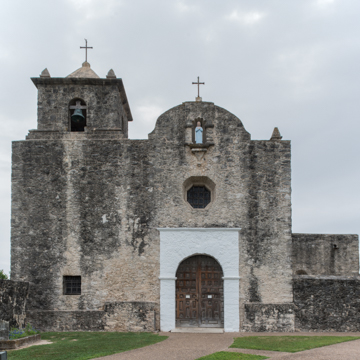Presidio La Bahía is an amalgam. It consists of the eighteenth-century presidio chapel, which, along with Mission Purísima Concepción in San Antonio, is the most intact Spanish building in Texas; the fort's defensive walls and the buildings attached to their interior surfaces, reconstructed between 1963 and 1967 on the foundations of the eighteenth-century fort to their appearance in March 1836; as well as a single house outside of and facing the west wall of the fort, reconstructed on its foundation in 1972.
The presidio not only protected the mission but also secured the military, communication, and trade routes from Saltillo, Coahuila (and Matamoros, Tamaulipas, after its spectacular rise in the 1820s), to Nacogdoches and eastern Texas, and from El Cópano on Cópano Bay to San Antonio de Béxar.
A civil settlement, called La Bahía, took form outside the west wall of the presidio during the second half of the eighteenth century. Mexican settlers, some of whom came to the region as presidio soldiers, established cattle ranches along the San Antonio, Guadalupe, Mission, and Nueces rivers. La Bahía ranked with Béxar and Nacogdoches as one of the three most important towns in Spanish Texas.
Presidio La Bahía is one of the major sites associated with the Texas Revolution of 1835– 1836. Anglo-Americans from Austin's colony and residents of the Goliad ayuntamiento seized the presidio in October 1835 and renamed it Fort Defiance. Although Mexican residents of Goliad tended to be Federalists, who opposed General Antonio López de Santa Anna's dissolution of state legislatures in 1835, they did not share the zeal of American immigrants for separating Texas from Mexico. By December 1835, when the Anglo-Americans promulgated the Goliad Declaration of Independence at La Bahía, the Mexican residents of Goliad had begun to flee to area ranches or to Matamoros. In February 1836, a force recruited in the United States under James Walker Fannin occupied the presidio. Fannin and his army were defeated at the Battle of Coleto on March 20, 1836, by General José de Urrea, who had entered Texas with Santa Anna's army to suppress the rebellion. Fannin and his men were returned to the presidio at Goliad, where approximately 400 were executed on March 27 in what Anglo-Americans called the Goliad Massacre.
The decision to restore Presidio La Bahía to its appearance in 1836 stems from the role it played in the Texas Revolution. United States boundary commissioner John Russell Bartlett, who visited the presidio in 1850, noted in his Personal Narrative of Explorations and Incidents in Texas (1854) that the chapel, then used as a dwelling house, was in a good state of preservation but that the presidio compound and the houses of the town, with only a few exceptions, were in ruins.
In the 1920s the chapel was rehabilitated and the top stage of the bell tower constructed to replace a collapsed predecessor. Hung in the tower were two bells associated with the chapel, one dated 1748 the other 1796. In 1963 Kathryn Stoner O'Connor (see VI31) committed the resources of her foundation to assist the Diocese of Corpus Christi, which had succeeded to ownership of the property, in reconstructing the presidio. O'Connor retained Raiford L. Stripling as architect and he assembled a number of the specialists who had worked at Espíritu Santo in the 1930s to plan the reconstruction of the fort.
The church is one bay wide and five bays long covered by a stone groin vault. A tower and a sacristy project from the north wall of the nave and a side chapel projects from the south wall. The interior is lit through octagonal clerestory windows. The most stunning element in the simple interior is the fresco painted on the sanctuary wall, South Texas Annunciation of 1946 by Corpus Christi artist Antonio García. Enshrined behind the altar is a votive statue of the church's patroness, Nuestra Señora de Loreto, believed to date from the early eighteenth century. During the Texas Revolution it was carried to Matamoros for safety but returned when the chapel was restored for use as a church. The votive statue of Our Lady of Loreto installed in a niche above the exterior entrance portal is by sculptor Lincoln Borglum.
Outside the west wall of the fort and near its southwest corner is the Ignacio Zaragoza Seguín house, reconstructed by Stripling for the Texas Parks and Wildlife Department in 1972. Born in La Bahía in 1829, Zaragoza was a liberal partisan who commanded the Mexican army at the Battle of Puebla, repelling a French expeditionary force on May 5, 1862 (celebrated as Cinco de Mayo, one of Mexico's major national patriotic holidays). The house is built of stone and faced with plaster. Two doors open toward the street onto a recessed stone banqueta. A side window is barred with wood. Wood lintels and projecting wood canales are the only other exterior architectural components. The austerity of the Zaragoza House matches that of the oldest extant houses in Laredo ( LA5) and San Ygnacio ( SM1) and their Tamaulipecan counterparts along the lower Rio Grande. What is unusual about the house is its isolation in a suburban setting of lawns and parking lots.


